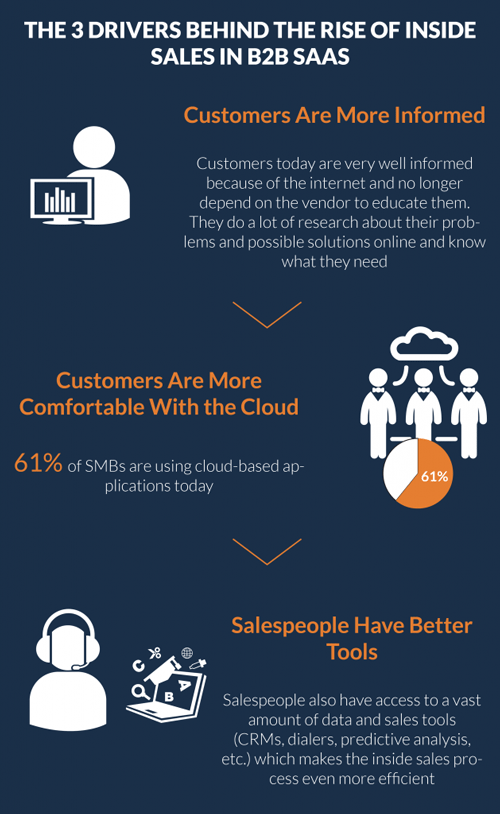When I started my career in software at Genesys in the ‘90s, nearly all our sales were handled by field reps. There were a handful of companies with small inside sales teams (usually called “telesales” back then), but their roles were limited to setting up appointments for field reps.
The typical sales process looked like this: a customer would find out about us through a trade show, a trade magazine article or advertisement. He would then give us a call, and we would schedule a meeting with his team, which consisted of Users that had a long list of formal requirements, and technical people. Once the meeting was set, we would fly-in a rep and a sales engineer to demo the product, understand the customer’s requirements and generally help him navigate the what solutions would meet his needs.
All this usually took several meetings. It was resource-intensive work – reps had to work over leads for months and sometimes, years before closing a sale – but there was no alternative. This was the only way to sell Enterprise B2B software back then. If you wanted to educate a customer about your product, or show off a demo, you had no choice but to do it in-person.
Over the next decade, as I started two software companies (NextAge and Contactual), I saw first-hand the dramatic shift in the way software was sold. We had no inside sales team at NextAge; by the time Contactual (which had no field sales team) was acquired, our inside sales team was closing six figure deals without meeting our clients face to face even once.
Interlude: A Quick Definition of Inside Sales
First, before I get ahead of myself, let us get the basics out of the way.
Inside sales is “sales done inside the building” i.e. without leaving the building and meeting the prospect face to face.
If you close a deal over the phone, it is inside sales. If a lead contacts you through your website and you close the deal after exchanging emails, it is inside sales. If you hold a webinar with a dozen prospective leads and sell the software to two of them, it is inside sales as well.
The definition gets a bit hazier here because it is hard to find a field rep who does not spend a third of his time working the phone and sending emails. Nearly every outside sales job has some inside sales component. When required, inside sales reps also go into the field to meet leads in-person. Salesforce’s “Corporate” Sales team, for example, was primarily an inside sales team but could visit a customer if it was deemed valuable the last week of the quarter. Most reps, however, never visited customers, opting to stay “inside” the building and work deals remotely instead.
It is a remarkable change that can be traced to three underlying drivers.
Three Things That Are Changing the Way Software is Sold
1. Customers know a lot more
It used to be that customers would come to technology vendors without knowing much about their products. It was the salesperson’s responsibility to educate customers and make them understand how they could help solve their problems.
“Our customers today are very well informed because of the internet”
This is not true anymore. Our customers today are very well informed because of the internet. They know their way around Google and typically do a lot of research about their problems and potential solutions. When they come to us, they often know exactly what they need. More often than not, they are already comparing our solution vs. our competitors’ before making a purchase decision.
Turns out, such informed customers are more comfortable buying your products over the phone than someone who knows little about your products or the industry in general. Educated customers are much more responsive to inside sales channels than those that need more handholding and education through the sales process.
2. Customers are more comfortable with the cloud
In the last ten years, SaaS has gone from a little known Valley term to the dominant enterprise tech buzzword. SaaS and cloud computing have seen double digit growth several years in a row. SaaS adoption is particularly strong among small and medium enterprises (61% of SMBs are using cloud-based applications today). Since many of these SMEs don’t have existing legacy solutions or extensive customization requirements, they are particularly receptive to SaaS offerings.
“[SaaS solutions]… typically fall in the Goldilocks range for inside sales of $7,500 to $100,000 of annual contract value.”
This is important for three reasons:
- Since customers are already using different SaaS products, they are much more comfortable buying SaaS software through inside sales channels. B2B SaaS products are also cheaper than their B2B Enterprise Software ancestors, which makes the inside sales process even smoother.
- Companies can offer trial accounts and give customers a fully functional working demo of what to expect from the software. If customers like what they see, they can simply dial the number on the website or drop an email, and the inside sales reps can close the deal.
- B2B SaaS solutions are typically an order of magnitude more affordable than traditional on Premise Software and typically fall in the Goldilocks range for inside sales of $7,500 to $100,000 of annual contract value. This lower barrier is also key to making the decision of selecting a vendor not a life or death decision.
3. Salespeople have better tools
Before the internet, email and smartphones, if you wanted to talk to a customer and understand his requirements, you had to do it in-person. There was simply no alternative.
Today, if my sales reps want to talk to customers or show them our products, they can choose from countless tools. They can:
- Walk the customer through a demo over web and video conferencing.
- Get in touch with the customer over social media, IM or email.
- Chat with a customer directly on the website with live chat.
- Schedule a webinar to talk to dozens of leads at a time.
- Finalize and sign an agreement electronically
- Pick up the phone and talk to the customer the good old-fashioned way.
In addition, salespeople also have access to a vast amount of data and sales tools (CRMs, dialers, predictive analysis, etc.) which makes the inside sales process even more efficient.
This is a win-win for everyone. Salespeople can talk to more leads and close more sales; customers can finalize a deal over an email and get back to running their companies.
The Future of Inside Sales is bright
Looking at the crystal ball is always difficult but in this case, I will make a prediction: Inside Sales is going to continue to grow and become a more dominant part of the sales equation. In the future there will be even more tools to support Inside Sales teams in interacting and engaging remotely with their customers.
The data seems to echo my experience: According to a Pacific Crest SaaS Study Companies that focused on Inside Sales grew their revenues 69% faster than companies focused on Field Sales.
Today, Inside sales teams are very efficient at selling medium complexity products at medium prices (Typical contract values $7,500 – $100,000). In the future, with more elaborate tools, more educated customers, and higher SaaS adoption, one could see the range of deals that inside sales reps handle grow in both dollar value and complexity.
Mansour Salame
Latest posts by Mansour Salame (see all)
- The Failed Sales Plan - May 20, 2016
- What Percentage of Leads Should You Close? - April 14, 2015
- Anatomy of an Inside Sales Team: The 5 Key Parts - February 25, 2015



Great summary of what’s changed and why Inside Sales is becoming the rule instead of the exception.
Along with being better informed and more comfortable with the cloud, I would add that the growth in Inside Sales is also because buyers are busier than ever. They simply don’t have time to meet with salespeople in person. As companies are forced to look for productivity gains (doing more with the same or fewer employees), decision-makers are overwhelmed with demands for their time.
Inside Selling combined with self-education on the web is a dynamic duo in today’s world of B2B.
This article is so relevant to so many businesses – I think it comes down to a cultural shift and establishing trust (that insides sales can really deliver)